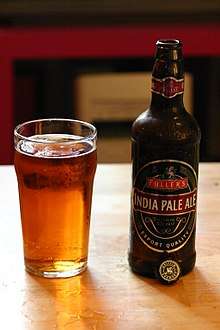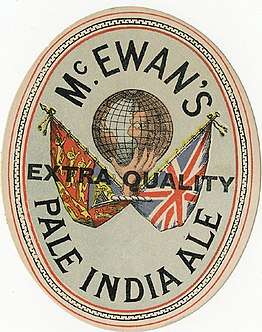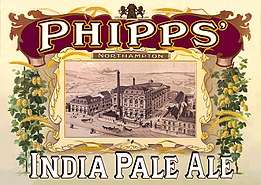India pale ale
| India Pale Ale | |
|---|---|
 India Pale Ale from Fuller's Brewery | |
| Country of origin | England |
| Alcohol by volume | 5.0% - 9.7% |
| Color (SRM) | 6 - 14 |
| Bitterness (IBU) | 40 - 60 |
| Original Gravity | 1.050 - 1.075 |
| Final Gravity | 1.010 - 1.018 |
_(14775748584).jpg)

India pale ale (IPA) is a hoppy beer style within the broader category of pale ale.[1]
The term "pale ale" originally denoted an ale brewed from pale malt.[2] Among the first brewers known to export beer to India was George Hodgson's Bow Brewery,[3] on the Middlesex-Essex border. Bow Brewery beers became popular among East India Company traders in the late 18th century because of the brewery's location near the East India Docks. Demand for the export style of pale ale, which had become known as India pale ale, developed in England around 1840 and it later became a popular product there.[4][5] IPAs have a long history in Canada and the United States, and many breweries there produce a version of the style.[6]
History
The pale ales of the early 18th century were lightly hopped and quite different from today's pale ales.[7] By the mid-18th century, pale ale was mostly brewed with coke-fired malt, which produced less smoking and roasting of barley in the malting process, and hence produced a paler beer.[8][9] One such variety of beer was October beer, a pale well-hopped brew popular among the landed classes, who brewed it domestically; once brewed it was intended to cellar two years.[10]

Among the first brewers known to export beer to India was George Hodgson's[3] Bow Brewery, on the Middlesex-Essex border. Bow Brewery beers became popular among East India Company traders in the late 18th century because of the brewery's location near the East India Docks[lower-alpha 1] and Hodgson's liberal credit line of 18 months. Ships transported Hodgson's beers to India, among them his October beer, which benefited exceptionally from conditions of the voyage and was apparently highly regarded among its consumers in India.[12] Bow Brewery came into the control of Hodgson's son in the early 19th century,[lower-alpha 2] but his business practices alienated their customers. During the same period, several Burton breweries lost their European export market in Russia when the Tsar banned the trade, and were seeking a new export market for their beer.[11]
At the behest of the East India Company, Allsopp brewery developed a strongly-hopped pale ale in the style of Hodgson's for export to India.[13][14] Other Burton brewers, including Bass and Salt, were eager to replace their lost Russian export market and quickly followed Allsopp's lead. Perhaps as a result of the advantages of Burton water in brewing,[lower-alpha 3] Burton India pale ale was preferred by merchants and their customers in India, but Hodgson's October beer clearly influenced the Burton brewers' India pale ales.
Brewer Charrington's trial shipments of hogsheads of "India Ale" to Madras and Calcutta in 1827 proved successful and a regular trade emerged with the key British agents and retailers: Griffiths & Co in Madras; Adam, Skinner and Co. in Bombay and Bruce, Allen & Co. in Calcutta.[15]
Early IPA, such as Burton brewers' and Hodgson's, was only slightly higher in alcohol than most beer brewed in his day and would not have been considered a strong ale; however, a greater proportion of the wort was well-fermented, leaving behind few residual sugars, and the beer was strongly hopped.[16] The common story that early IPAs were much stronger than other beers of the time, however, is a myth.[17] While IPAs were formulated to survive long voyages by sea better than other styles of the time, porter was also shipped to India and California successfully.[18] It is clear that by the 1860s, India pale ales were widely brewed in England, and that they were much more attenuated and highly hopped than porters and many other ales.[19]
Demand for the export style of pale ale, which had become known as India pale ale, developed in England around 1840 and India pale ale became a popular product in England.[4][5] Some brewers dropped the term "India" in the late 19th century, but records indicated that these "pale ales" retained the features of earlier IPAs.[20] American, Australian, and Canadian brewers manufactured beer with the label IPA before 1900, and records suggest that these beers were similar to English IPA of the era.[21][22]
IPA style beers started being exported to other colonial countries, such as Australia and New Zealand, around this time with many breweries dropping the 'I' in 'IPA' and simply calling them Pale Ales or Export Pales. Many breweries, such as Kirkstall Brewery, sent large quantities of export beer across the world by steam ship to auction off to wholesalers upon arrival.
United Kingdom
.jpg)
India Pale Ale, or IPA, has been used in the United Kingdom to describe a well-hopped, high-gravity beer since 1835. It gained popularity in the domestic market after 1841.[23] The term IPA is still commonly used in the United Kingdom. It is a type of beer offered by many brewers in the UK. To conform to the style, Modern British IPAs should be in the range 40-60 IBU with alcohol in the range 5% to 8%. The modern incarnation is described as "A hoppy, moderately-strong, very well-attenuated pale British ale with a dry finish and a hoppy aroma and flavour".[24]
Some beers, for example Greene King IPA and Charles Wells Eagle IPA are marketed with the initials IPA despite actually being examples of ordinary bitters. In the opinion of the Campaign for Real Ale, "so-called IPAs with strengths of around 3.5% are not true to style",[25] although IPAs with an abv of 4% or lower have been brewed in Britain since at least the 1920s.[26]
Canada
Strong and bitter IPA is a popular style in the Canadian craft beer industry.[27] AB-InBev produces a Canadian beer called "Alexander Keith's IPA". Because it is only 5% abv and lightly hopped, purists and craft brewers point out that it does not meet the accepted criteria for an IPA.[27] When exported to the United States, AB-Inbev labels this beer "Alexander Keith's Nova Scotia Style Pale Ale".[28]
United States
IPAs have a long history in the United States, and many breweries there produce a version of the style.[6] Contemporary American IPAs are typically brewed with distinctively American hops, such as Cascade, Centennial, Citra, Columbus, Chinook, Simcoe, Amarillo, Tomahawk, Warrior, Neomexicanus, and Nugget.
East Coast IPAs are distinguished from West Coast IPAs by a stronger malt presence, which balances the intensity of the hops, whereas hops are more prominent in the western brews, possibly because of the proximity of West Coast breweries to hop fields in the Pacific Northwest. East Coast breweries rely more on spicier European hops and specialty malts than those on the West Coast.[29][30][31]
Double IPAs (also referred to as Imperial IPAs) are a stronger, very hoppy variant of IPAs that typically have alcohol content above 7.5% by volume.[32] The style is claimed to have originated with Vinnie Cilurzo, currently the owner of Russian River Brewing Company in Santa Rosa, California, in 1994 at the now-defunct Blind Pig Brewery in Temecula, California.[lower-alpha 4] The style has been embraced by the craft brewers of San Diego County, California, to such an extent that double IPAs have been referred to as "San Diego pale ale" by Garrett Oliver, brewmaster at the Brooklyn Brewery.[33][34]
In the United States, sales of IPAs have increased, helping drive the craft beer renaissance.[35]
New England India pale ales are a style of IPA invented in Vermont in the early 2010s. They are characterized by juicy, citrus, and floral flavours, with a more subtle and less piney hop taste than typical IPAs. They also have a smooth consistency or mouthfeel, and a hazy appearance. These characteristics are achieved using a combination of brewing techniques, including the use of particular strains of yeast, the timing of adding the hops, and adjusting the chemistry of the water.[36][37][38][39] The style has become popular among New England brewers. New England IPAs need not be brewed in New England.[40] It was officially recognized as a separate beer style by the Brewers Association in 2018.[41]
India pale lager
India pale lager (IPL) is a hoppy beer style inspired by India pale ale. But unlike IPAs, IPLs are fermented with a lager yeast strain at lager fermentation temperatures. They generally combine a crisp lager finish with amplified hops.[42][43]
Footnotes
- ↑ The Bow Brewery was on the banks of the River Lea near Bow bridge. The East India Docks lay two miles down river.[11]
- ↑ Mark Hodgson died in 1810, leaving the Bow Brewery in the care of a trust. His only surviving son, Frederick Hodgson, took control of the brewery in 1819.[11]
- ↑ The water of Burton on Trent contains a very high concentration of sulphate which accentuates the bitterness of beer. See Daniels, Foster, and Cornell.
- ↑ The double IPA, though, is not quite a native, even though Vinnie Cilurzo is credited with creating the style in 1994, when he was running Blind Pig Brewery in Temecula. Blind Pig IPA set the bar high and bitter – the recipe called for four varieties of malts, but the intensely aromatic and bitter hops were the super star.
References
- ↑ North, Andrew. "The return of the Indian Pale Ale". BBC. Retrieved 13 April 2017.
- ↑ Anonymous 1744, pp. 39–43
- 1 2 "How the India Pale Ale Got Its Name". Smithsonianmag.com. Retrieved 6 November 2017.
- 1 2 Daniels 1996, p. 155
- 1 2 Cornell 2008, p. 104
- 1 2 Jackson 1978, p. 210
- ↑ Anonymous 1744, pp. 72–73
- ↑ Foster 1999, p. 13
- ↑ Daniels 1996, p. 154
- ↑ Cornell 2008, pp. 97–98
- 1 2 3 Pryor, Alan (2009). "Indian Pale Ale: an Icon of Empire" (PDF). Commodities of Empire Working Paper (13). ISSN 1756-0098. Retrieved 17 February 2015.
- ↑ Cornell 2008, p. 98
- ↑ Foster 1999, p. 26
- ↑ Cornell 2008, p. 102
- ↑ Mathias 1959, p. 190.
- ↑ Foster 1999, pp. 17–21 discusses the hopping rate; Daniels 1996, p. 154 discusses the high level of fermentation.
- ↑ Foster 1999, p. 21
- ↑ "IN THE ROOM THE STORY OF ANCHOR IPA™". Anchor Brewing Blog. Anchor Brewing Company. Retrieved 28 April 2014. .
- ↑ Daniels 1996, p. 156
- ↑ Foster 1999, p. 65
- ↑ Daniels 1996, pp. 157–58
- ↑ Cornell 2008, p. 112
- ↑ "IPA: the executive summary". Zythophile.co.uk. 31 March 2010. Retrieved 6 November 2017.
- ↑ "Beer Judge Certification Program: 2015 Style Guidelines" (PDF). Bjcp.org. Retrieved 6 November 2017.
- ↑ "Pale Ale or IPA - CAMRA". CAMRA. Retrieved 6 November 2017.
- ↑ "Brewing records". London Metropolitan Archives: Whitbread and Barclay Perkins.
- 1 2 Doherty, Mike (2011-08-05), "Canadians' love affair with India Pale Ale: Why so many Canadian brewers are making IPAs", MacLean's, retrieved 2018-09-13
- ↑ Ramsay, Reid (2011-06-14), "Alexander Keith's Hits 22 States", Beer Street Journal, retrieved 2018-09-13
- ↑ Henry, Jason (13 September 2012). "Beer of the Week: New Belgium/Alpine Super India Pale Ale". SF Weekly (blog). Retrieved 26 September 2012.
- ↑ Kitsock, Greg (20 June 2007). "A Bitter Divide". The Washington Post. Retrieved 26 September 2012.
- ↑ Juskewitch, Ezra (10 September 2012). "The Hop Report: Summer brews great alternative to fall ales". The Maine Campus. Retrieved 26 September 2012.
- ↑ "American Double IPA" Archived 2014-12-07 at the Wayback Machine. Beer Advocate. Retrieved 30 May 2013.
- ↑ Rowe, Peter (March 8, 2006). "Some believe bitter brew should be renamed to reflect San Diego roots". Legacy.utsandiego.com. Retrieved 21 January 2014.
- ↑ "10 events that rocked our beer mugs, 1996-2006". San Diego Union Tribune. January 17, 2007. Retrieved 18 June 2013.
- ↑ "Is IPA responsible for the growth of the craft beer industry? - Beer News". Beer News. Retrieved 2016-01-31.
- ↑ Alström, Jason; Alström, Todd (May 2017). "It's Official: New England India Pale Ale Is a Style". Beer Advocate. Retrieved 6 November 2017.
- ↑ Noel, Josh (5 July 2017). "How I learned to stop worrying and love hazy IPA — some hazy IPA". Chicago Tribune. Retrieved 25 November 2017.
- ↑ Moorhead, John (August 2016). "New England IPA: The Haze Craze". American Homebrewers Association. Retrieved 25 November 2017.
- ↑ Sparhawk, Andy (2 August 2017). "The New England Style IPA Is the Anti-IPA". CraftBeer.com. Retrieved 25 November 2017.
- ↑ Stein, Jason (8 June 2017). "The Haze Craze: 11 Breweries Outside of New England Making NE IPAs". Paste Magazine. Retrieved 25 November 2017.
- ↑ https://www.bostonmagazine.com/restaurants/2018/03/20/brewers-association-guidelines-new-england-ipa/
- ↑ Bernot, Kate (10 March 2016). "What the hell's an IPL?". Draft Magazine. Retrieved 25 November 2017.
- ↑ Colby, Chris (4 April 2014). "India Pale Lager". Beer & Wine Journal. Retrieved 25 November 2017.
Bibliography
- Anonymous (1744). The London and Country Brewer. London: Thomas Astley. OCLC 22476249.
- Cornell, Martyn (2008). Amber, Gold & Black: The Story of Britain's Great Beers. Zythography Press.
- Daniels, Ray (1996). Designing Great Beers: The Ultimate Guide to Brewing Classic Beer Styles. Brewers Publications. ISBN 978-0-937381-50-2.
- Foster, Terry (1999). Pale Ale: History, Brewing Techniques, Recipes (Second ed.). Brewers Publications. ISBN 978-0-937381-69-4.
- Jackson, Michael (1978). The World Guide to Beer. Ballantine Books. ISBN 978-0-345-27408-3.
- Mathias, Peter (1959). The Brewing Industry in England 1700-1830. CUP Archive. GGKEY:DYD5N29F6JD.
Further reading
- Brown, Pete (2009), Hops & Glory: One Man's Search for the Beer That Built the British Empire, Pan Macmillan
- Steele, Mitch (2012). IPA: Brewing Techniques, Recipes, and the Evolution of India Pale Ale. Brewers Publications. ISBN 978-1-938469-00-8.
